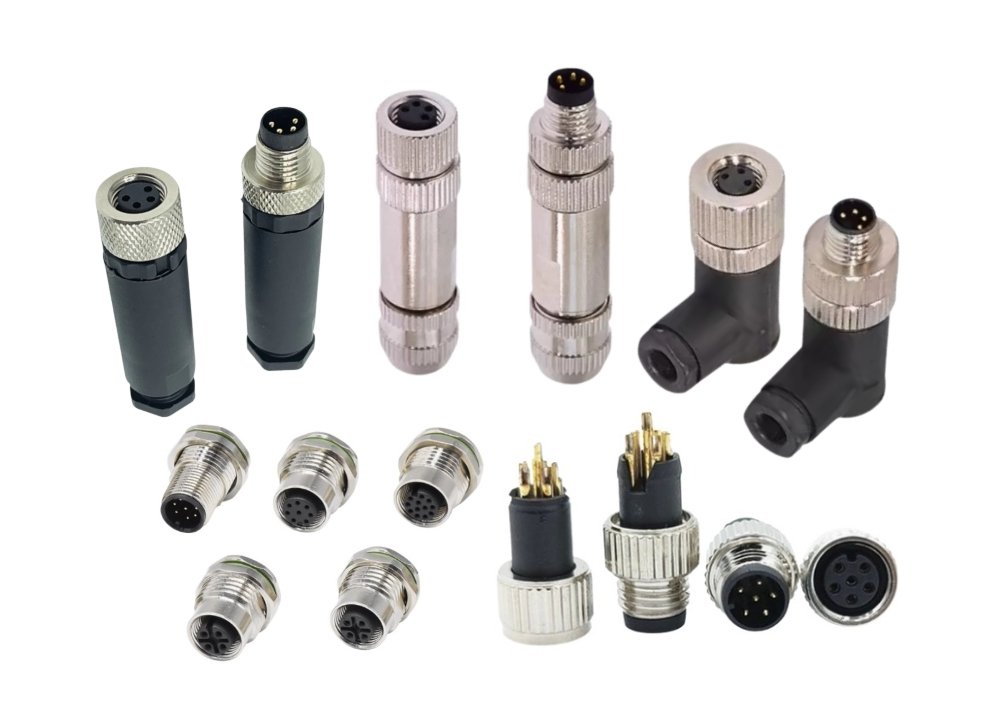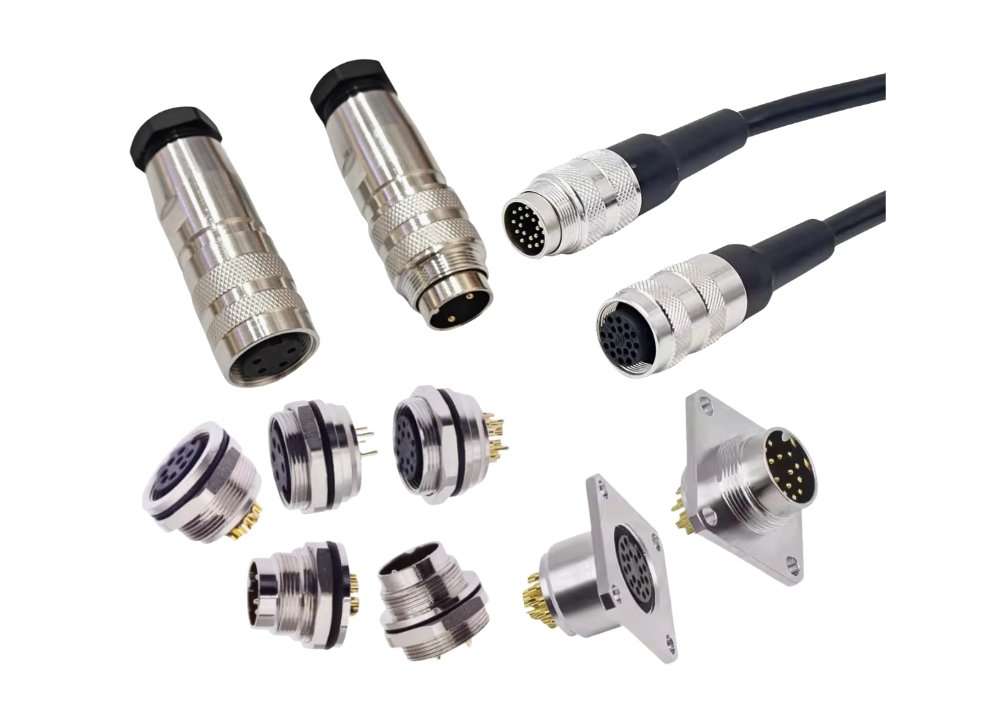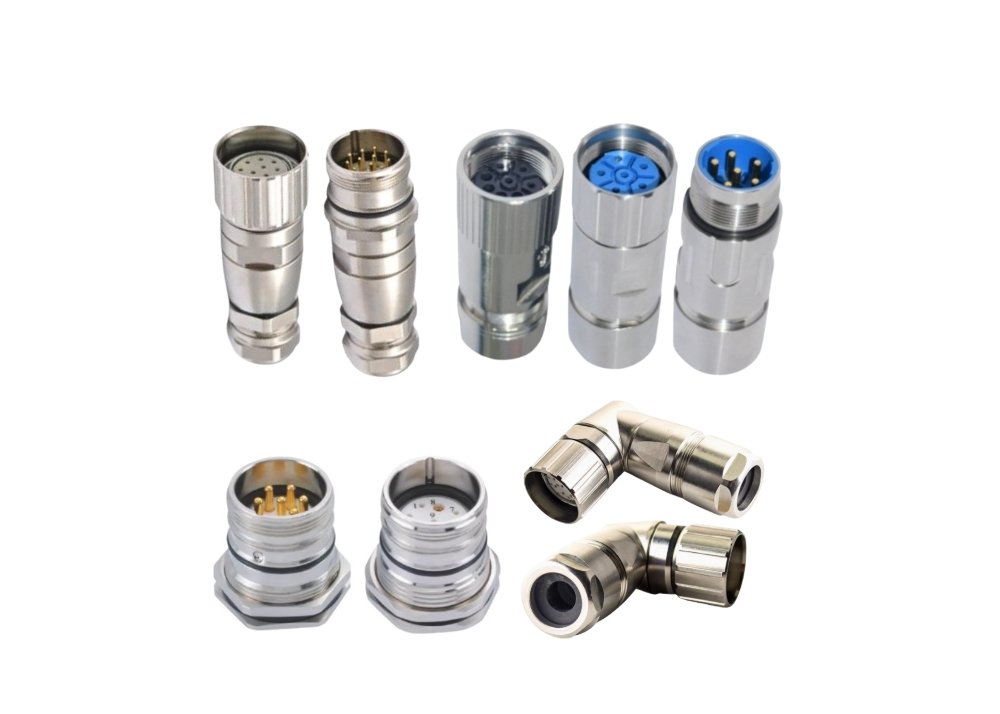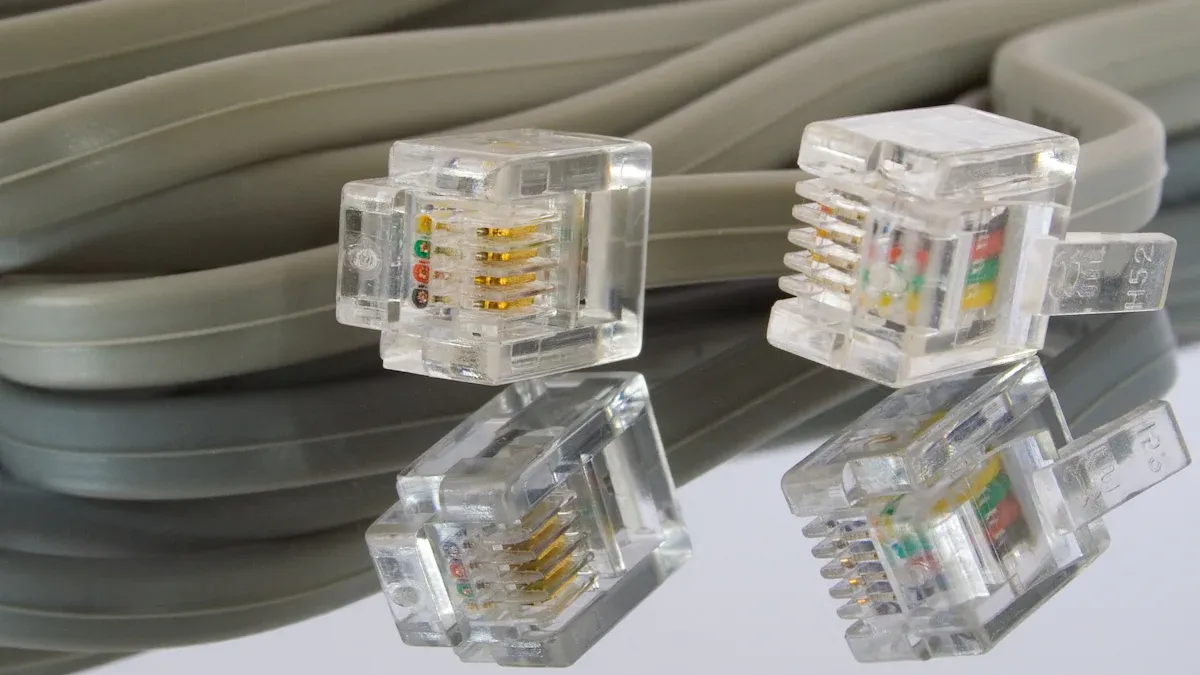
Binder connector technology supports uninterrupted signal transmission in critical sectors such as telecommunications, automotive, and industrial automation. The connector market, valued at nearly USD 80 billion in 2024, continues to expand as industries demand high-performance solutions for harsh environments. Binder engineers precision components like the M8 connector and Type B connector, ensuring devices maintain connectivity and optimal performance. The connector factory at Binder produces robust products that withstand daily wear, helping businesses achieve reliable results in every application.
What Is Binder Connector Technology?
Definition and Overview of Binder Connectors
Binder connector technology forms the backbone of reliable device connectivity in modern industries. These connectors serve as essential components that enable secure and efficient signal transmission between devices. Binder engineers each connector with a focus on durability, precision, and adaptability, ensuring that devices maintain optimal performance even in challenging environments.
What Sets Binder Connector Technology Apart
Binder connector technology stands out due to its robust design principles and advanced engineering. The core components of Binder connectors include a variety of coding systems, such as A, B, D, X, S, K, T, and L, which tailor each connector for specific signal, data, or power applications. Pin configurations range from 3 to 12 pins, allowing flexibility for different requirements. Locking systems, including push-pull, threaded coupling, and bayonet mechanisms, provide secure connections and prevent accidental disconnection.
Key design principles focus on ruggedness, with ingress protection ratings from IP67 up to IP69K. These ratings ensure resistance to dust, water, impact, vibration, UV exposure, and temperature fluctuations. Binder connectors also feature EMI shielding through conductive metal housings and 360° cable shield termination, maintaining signal integrity in industrial environments. Compact sizes, such as the 12mm diameter of M12 connectors, support miniaturization trends in Industry 4.0, making them ideal for space-constrained applications.
Additional customizable features include gender options, various termination styles, housing and contact plating materials, and cable specifications. These components guarantee that Binder connectors remain reliable and durable in harsh industrial settings.
The Role of Connectors in Signal Transmission
Connectors play a critical role in ensuring uninterrupted signal transmission. Binder connector technology uses high-quality materials and precise manufacturing to minimize signal loss and interference. The integration of EMI shielding and secure locking mechanisms ensures that signals remain stable, even in environments with high electromagnetic noise or mechanical stress. These components help maintain consistent electrical contact, which is vital for the performance of sensitive electronic systems.
Types of Connectors in Binder’s Portfolio
Binder offers a comprehensive portfolio of connectors designed for a wide range of applications. The portfolio includes circular connectors, power connectors, medical connectors, and specialized solutions for automation technology.
Circular Connectors and Their Advantages
Circular connectors represent a significant segment of Binder’s offerings. These connectors provide several advantages:
- Compact design, suitable for space-limited installations.
- High protection ratings, such as IP67, making them resistant to dust and moisture.
- Mechanically stable locking systems, such as screw or bayonet couplings, which ensure secure connections in vibrating or mobile environments.
- Multiple pin counts, supporting diverse application needs.
| Connector Category | Typical Use Cases |
|---|---|
| M12 Panel Mount Connectors | Automation, industrial data communication, sensor integration, robotics, railway systems |
| M8, M5 Connectors | Sensors and actuators in automation technology |
| Power Connectors | Power supply applications including AC and DC power transmission |
| Medical Connectors | Medical applications requiring reliable and compact connections |
| Specialized Automation Connectors | Data transmission, solenoid valve connectors, hybrid connectors, and other automation-specific needs |
Circular connectors from Binder excel in industrial automation, transportation, and medical technology, where reliability and compactness are essential.
Custom and Application-Specific Connector Solutions
Binder also provides custom and application-specific connector solutions. The Plug&Play portfolio integrates well-established connector types, such as Deutsch DT and AMP Superseal, with Binder’s own connectors. These solutions offer ready-to-connect, pre-assembled, and tamper-proof options tailored for mobile machines in agriculture and construction. Binder supports flexible combinations of different connector systems, reducing cabling effort and ensuring process-safe connections. The company enables customized connectivity even for small quantities, supporting individualization in demanding industrial and mobile applications.
Key Features of Binder Connector Technology for Reliable Signal Transmission
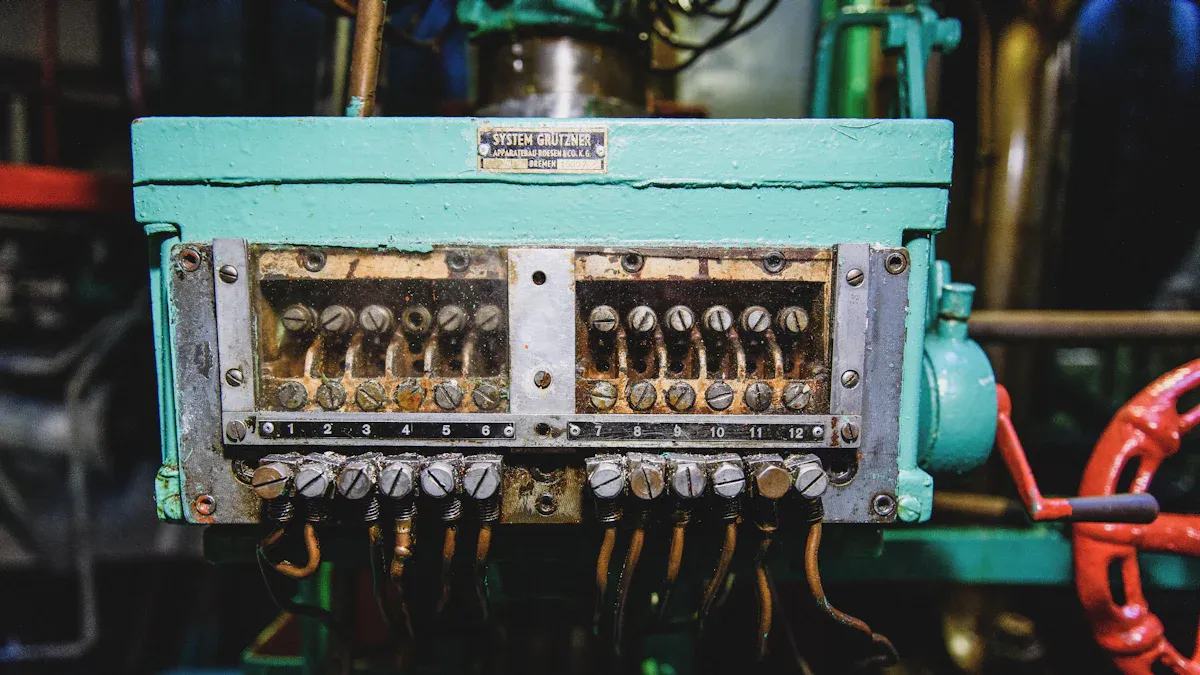
Precision Engineering in Connectors
Tight Tolerances and Manufacturing Quality
Binder connectors demonstrate exceptional precision engineering. The company maintains a vertically integrated business model, managing cable assembly, zinc die casting, and circuit board production in-house. This approach allows Binder to control every step of the manufacturing process, ensuring each connector meets strict quality standards. Facilities in Germany, the USA, and Hungary operate under rigorous guidelines, producing connectors that comply with international standards such as IEC 60529 for IP ratings. These standards guarantee mechanical stability, signal integrity, and environmental sealing.
The manufacturing process also aligns with environmental directives, including the EU RoHS2 directive, which ensures lead-free production. Redesigned molded M16 connectors, for example, meet both the M16 standard (DIN EN 61076-2-106) and the AISG standard for shielded variants, confirming cross-manufacturer compatibility and IP68 sealing. This level of quality control results in connectors that deliver consistent performance and high reliability in demanding applications.
High-Quality Materials for Signal Integrity
Binder selects materials with care to optimize signal integrity. The use of metals such as stainless steel, aluminum, and brass, along with high-performance polymers like PEEK and PTFE, provides strength and resistance to corrosion and chemicals. These materials help maintain stable electrical contact and reduce signal loss, even in harsh industrial environments. Conductive metal housings offer effective EMI shielding, protecting sensitive signals from electromagnetic interference.
Note: Precision engineering, combined with careful material selection, ensures that connectors maintain their performance over time, even as industrial systems evolve to require higher bandwidth and modularity.
Robust Design of Binder Connectors
Resistance to Vibration and Mechanical Stress
Binder connectors are engineered to withstand significant mechanical stress. The design incorporates features such as threaded locking mechanisms, which use screw-type engagement to prevent loosening under vibration. Bayonet and push-pull locking systems provide additional options for secure connections, each suited to different application needs. Snap-in locking, with spring-loaded apparatus, allows for quick installation in compact spaces.
- Threaded locking mechanisms deliver a robust mechanical bond, ideal for environments with constant vibration.
- Bayonet locking offers quick-connect capability with reliable vibration resistance.
- Push-pull and snap-in locking enable fast, tool-free mating and secure engagement.
Binder connectors meet the DIN EN 61076-2-109 standard for mechanical robustness and vibration resistance. For railway applications, they comply with the stricter DIN EN 61373 shock and vibration tests. Advanced materials, including those meeting EN 45545-2 fire safety requirements, further enhance durability. M12 stainless steel connectors, for instance, demonstrate high mechanical load capacity with over 500 to 1,000 mating cycles, supporting long-term use in industrial and outdoor settings.
Protection Against Moisture and Dust (IP67 and Beyond)
High IP ratings, such as IP67, IP68, and IP69K, ensure that Binder connectors remain sealed against dust, water, and other contaminants. These ratings confirm that the connectors can operate reliably in environments exposed to moisture, chemicals, and dirt. Integrated protective conduits, UV-resistant housings, and protective caps add further layers of defense, making these connectors suitable for outdoor and industrial applications.
Performance in Extreme Temperatures
Binder designs connectors to perform across a wide temperature range. The use of robust materials and specialized coatings allows connectors to resist thermal cycling, UV exposure, and rapid temperature changes. This resilience ensures that connectors maintain their function and signal quality in both high-heat and sub-zero environments, supporting applications from factory automation to transportation systems.
Secure Locking Mechanisms in Connectors
Preventing Accidental Disconnection
Secure locking mechanisms play a vital role in preventing accidental disconnection. Binder offers a variety of locking systems, including screw, push-pull, bayonet, and snap-in types. The Easy Locking Connector (ELC) series, for example, uses snap-in hooks that automatically lock when mated. These hooks require a special tool for detachment, providing a clear visual and tactile indication of secure engagement. The asymmetric hexagon shape in the mating area prevents mismating and supports blind mating, which is especially valuable in medical and industrial settings.
- Snap-in locking (IP67 rated) ensures quick, tool-free installation.
- Bayonet locking (IP40 rated) provides reliable engagement with a quarter-turn.
- Push-pull locking (IP67 rated) offers fast, secure connections with a clear click.
Binder’s M8 and M12 connectors utilize these mechanisms to deliver secure, vibration-resistant connections. The newly standardized M12 push-pull connectors, developed in collaboration with other manufacturers, introduce a mechanism that is interchangeable with traditional screw-type connectors. This advancement enhances installation speed and reliability, addressing previous market fragmentation.
Ensuring Consistent Electrical Contact
Consistent electrical contact is essential for reliable signal transmission. Binder connectors use locking mechanisms that maintain stable connections, even under vibration or mechanical shock. The design ensures that electrical contacts remain engaged, reducing the risk of signal loss or intermittent connections. This focus on secure engagement supports the performance of sensitive equipment in sectors such as automation, transportation, and healthcare.
Tip: Choosing the right locking mechanism for your application can minimize downtime and maintenance, ensuring that devices remain connected and operational in all conditions.
How Binder Connectors Maintain Signal Integrity
Shielding and Electromagnetic Compatibility
Reducing Signal Loss and Crosstalk
Binder connectors play a crucial role in preserving the quality of data transmission. These connectors use advanced shielding techniques to minimize signal loss and reduce crosstalk between adjacent wires. Crosstalk can disrupt data transmission, especially in environments with multiple electronic devices operating simultaneously. Binder’s M9 series connectors feature an internal iris spring that creates a continuous 360° connection between the cable shield and the connector body. This design ensures that the shield remains intact throughout the entire connector, which is essential for maintaining the integrity of data signals.
The 360° shielding approach simplifies the installation of braided or metal foil shields. It also enhances the overall effectiveness of electromagnetic compatibility (EMC) measures. By maintaining a consistent shield, Binder connectors help prevent unwanted signals from interfering with data transmission. This level of protection is vital for applications that require high-speed data transmission, such as industrial automation and sensor networks.
Electromagnetic Interference Protection
Electromagnetic interference (EMI) poses a significant threat to reliable data transmission. Binder connectors address this challenge by implementing comprehensive EMC shielding. The M5 series connectors, for example, use screw locking to maintain shielding effectiveness even in compact installations. These connectors achieve shielding attenuation values up to 60 dB at frequencies around 1 GHz. This high level of attenuation ensures that external electromagnetic fields do not compromise the quality of data transmission.
Binder connectors also provide mechanical robustness, which helps them withstand shock and vibration. This durability is critical for maintaining signal integrity in industrial environments. The optimized 360° shielding not only protects against EMI but also supports high-frequency data transmission in harsh outdoor conditions. With a high protection rating such as IP68, these connectors ensure environmental robustness and reliable performance, even in demanding applications like 5G networks.
Note: Effective EMI protection in Binder connectors guarantees that sensitive data signals remain stable, supporting the reliability of complex electronic systems.
Consistent Contact Resistance in Connectors
Gold-Plated Contacts and Corrosion Resistance
Consistent contact resistance is essential for uninterrupted data transmission. Binder connectors use gold-plated contacts to achieve low and stable resistance at the connection points. Gold resists oxidation and corrosion, which can otherwise increase resistance and disrupt data transmission. The use of high-quality materials ensures that connectors maintain their performance over time, even when exposed to moisture or chemicals.
Gold-plated contacts also provide excellent conductivity, which supports the reliable flow of data signals. This feature is especially important in applications that require frequent mating and unmating of connectors. By maintaining low contact resistance, Binder connectors help prevent signal degradation and ensure the accuracy of data transmission.
Long-Term Reliability in Repeated Use
Binder connectors are designed for long-term reliability, even under repeated use. The robust construction and careful selection of materials allow these connectors to withstand thousands of mating cycles without significant wear. Consistent contact resistance remains a key factor in ensuring reliable data transmission throughout the lifespan of the connector.
The combination of gold-plated contacts, durable housing materials, and advanced shielding techniques enables Binder connectors to deliver dependable performance in a wide range of applications. Whether used in industrial automation, medical devices, or communication systems, these connectors support the continuous and accurate transmission of data.
- Gold-plated contacts resist corrosion and maintain low resistance.
- Robust mechanical design ensures connectors perform reliably over time.
- Advanced shielding protects data transmission from external interference.
Tip: Regular inspection and proper handling of connectors can further extend their service life and maintain optimal data transmission quality.
Real-World Applications of Binder Connector Technology

Medical Devices and Healthcare Equipment
Patient Monitoring and Diagnostic Systems
Binder connectors play a vital role in patient monitoring and diagnostic systems. These connectors ensure reliable data transmission between sensors and monitoring equipment. Medical professionals depend on accurate real-time data to make critical decisions. Binder connectors offer durability, environmental resistance, and ergonomic design, which support frequent connections and disconnections without compromising signal integrity. The snap-in locking mechanism provides secure connections, reducing the risk of accidental disconnection during patient care.
| Feature/Aspect | Description |
|---|---|
| Durability | Designed to withstand frequent connections/disconnections without compromising signal integrity. |
| Environmental Resistance | Resistant to dust, moisture, chemical exposure, and high-temperature disinfection. |
| Ease of Use | Ergonomic grip, tactile feedback, and clear indicators reduce connection errors and delays. |
| Locking Mechanism | Snap-in locking system provides secure, intuitive connection with tactile feedback. |
| Biocompatibility | Complies with ISO 10993; DEHP-free; suitable for patient monitoring devices. |
| Protection Rating | IP67 rated for protection against dust and water ingress. |
| Application Examples | Used in MRI diagnostics, infiltration pumps, muscle massage devices, and other patient monitoring tools. |
Imaging and Life-Support Devices
Medical imaging and life-support devices require uninterrupted data transmission and power supply. Binder connectors meet strict standards such as ISO 13485 and DIN EN 60601, ensuring safety and compliance. The robust design resists shock, vibration, and cleaning agents. Biocompatible materials and high protection ratings (IP67, IP68) make these connectors suitable for sensitive environments. The connectors support real-time data transmission, which is essential for imaging equipment and life-support systems. Customization options allow integration with various cables and terminations, supporting the unique needs of medical applications.
Industrial Automation and Robotics
Sensors, Actuators, and Control Systems
Binder connectors support industrial automation by enabling reliable data transmission between sensors, actuators, and control systems. The M12 connector series, including T-coded and L-coded variants, provides mechanical resilience and electrical performance in harsh industrial environments. These connectors feature IP67 protection, stainless steel locking, and operation across extreme temperatures. They support industrial ethernet protocols such as PROFINET, EtherCAT, and CAN bus, ensuring stable power and data transmission. The standardized coding prevents mismatched connections, enhancing safety and reducing installation errors.
Industrial ethernet cables connect devices across the network, supporting deterministic real-time communication. Binder connectors withstand vibration, dust, and moisture, making them ideal for robotics applications like assembly and material handling. The connectors’ multi-pin configurations and customer-specific assemblies enable flexible integration with industrial sensor technology.
m8 12-pin Circular Connector in Industrial Communication
The m8 12-pin circular connector has become a standard in industrial ethernet applications. This connector supports high-density data transmission in compact spaces. Engineers use the m8 12-pin circular connector to connect sensors, actuators, and controllers, ensuring reliable real-time data transmission. The connector’s robust design resists vibration and environmental stress, maintaining stable data transmission even in challenging conditions. The m8 12-pin circular connector enables seamless integration with industrial ethernet networks, supporting protocols like EtherCAT and PROFINET. Its compact size and secure locking mechanism make it suitable for space-constrained installations, while its compatibility with various cables ensures flexible deployment.
Transportation and Mobility Solutions
Automotive Electronics and Electric Vehicles
Binder connectors support automotive electronics and electric vehicles by providing reliable data and power transmission. These connectors withstand vibration, temperature fluctuations, and exposure to dust and moisture. Automotive engineers use Binder connectors to ensure stable data transmission between control units, sensors, and battery management systems. The connectors’ robust locking mechanisms prevent accidental disconnection, supporting the safety and reliability of electric vehicles.
Railway and Mass Transit Systems
Railway and mass transit systems demand connectors that maintain data transmission under constant vibration and harsh environmental conditions. Binder connectors meet these requirements with high protection ratings and compliance with railway standards. The connectors support industrial ethernet networks, enabling real-time data transmission for signaling, communication, and passenger information systems. Their durability and secure locking mechanisms ensure continuous operation, reducing maintenance needs and service interruptions.
Note: Binder connectors deliver reliable data transmission and power supply across diverse sectors, supporting the demands of modern industrial, medical, and transportation systems.
Aerospace and Defense Applications
Avionics and Flight Control Systems
Aerospace systems demand components that deliver flawless performance under extreme conditions. Binder connectors, especially the M16 series, support avionics and flight control systems by offering high pin counts in a compact form. These connectors transmit data at speeds up to 10 Gbits/s, which is essential for real-time communication between flight instruments and control units. The compact design accommodates cables from 4.0 to 10 mm in diameter, making them suitable for tight spaces within aircraft.
Engineers rely on Binder connectors for their robust construction and advanced shielding. The integral 360º shielding rings provide excellent protection against electromagnetic interference (EMI), ensuring that sensitive avionics signals remain stable even in environments with high EMI exposure. The connectors also handle currents up to 7A at 40ºC and are rated for 250V, supporting both power and data needs in flight systems. Their compliance with IP68 sealing and the M16 standard (DIN EN 61076-2-106) guarantees resistance to dust, moisture, and vibration. This reliability helps maintain continuous operation of critical flight control systems.
Military Communication and Navigation Equipment
Military operations require equipment that performs reliably in the harshest environments. Binder connectors are engineered to resist extreme temperatures, high humidity, chemical exposure, dust, vibration, and shock. Their circular design simplifies connection and disconnection, even when operators wear gloves or work in sub-zero temperatures. The sealed M16 connectors feature a robust triangular grip, which enhances handling during field operations.
These connectors support both power and data transmission for military communication and navigation equipment. The environmental sealing, including compliance with IP68 and AISG standards, ensures protection against water and dust ingress. Binder connectors also meet the EU RoHS2 directive, confirming lead-free and environmentally responsible manufacturing. Their rugged mechanical design and standards compliance make them a trusted choice for mission-critical military systems, where failure is not an option.
Renewable Energy and Environmental Systems
Solar Power Installations
Solar power installations operate in challenging outdoor environments. Binder M12 D-coded cable assemblies provide reliable connectivity for Industrial Ethernet networks within these systems. The connectors deliver 360º EMI shielding, which protects data transmission from interference caused by nearby electrical equipment or weather events. Their anti-vibration and shock-resistant features ensure stable connections, even when solar panels experience wind or mechanical movement.
The connectors’ resistance to UV, oil, gas, and chemicals makes them ideal for prolonged outdoor use. The IP67 rating guarantees protection against dust and water ingress, supporting uninterrupted operation in all weather conditions. These qualities help solar power systems maintain efficient data and power transmission, maximizing energy output and system reliability.
Wind Energy and Smart Grid Devices
Wind turbines and smart grid devices require connectors that withstand constant motion and exposure to the elements. Binder connectors excel in these applications due to their robust construction and environmental resistance. The M12 D-coded assemblies ensure secure data transfer, even as turbines rotate and vibrate. Their EMI shielding maintains signal integrity, which is vital for real-time monitoring and control of wind energy systems.
Key benefits of Binder connectors in renewable energy systems include:
- 360º EMI shielding for complete data protection
- Anti-vibration and shock resistance for durability
- Resistance to UV, oil, gas, and chemicals
- Reliable IP67 sealing against dust and water
These features enable wind energy and smart grid installations to operate efficiently and reliably, supporting the transition to sustainable energy solutions.
Binder Connectors vs. Other Connector Types
Reliability and Performance Comparison
Durability Under Mechanical and Environmental Stress
Binder connectors demonstrate exceptional durability in challenging environments. Their exclusive focus on circular waterproof connectors with high IP ratings, such as IP67, IP68, and IP69K, ensures strong protection against dust, water, and pressure. Automated CNC manufacturing delivers consistent quality and precision, supporting mechanical reliability across applications. Binder’s unique NCC (Not Connected Closed) technology maintains IP67 protection even when connectors are unmated, which enhances environmental robustness.
- Binder offers specialized series for harsh conditions, including the 620/720 Series (snap-in waterproof to IP67), 693 Series (VDE certified for medical equipment), 770 Series NCC (protected when unmated), and 713 Stainless (chemical resistant IP69K).
- Their connectors have proven durability in demanding applications, such as acid-resistant connectors surviving daily sanitization in breweries.
- Binder’s exclusive specialization in circular connectors allows for rigorous adherence to DIN standards, including DIN 40050-9 for waterproof and mechanical stress testing.
This combination of specialized design, rigorous manufacturing, and customization capabilities positions Binder connectors as highly reliable under mechanical and environmental stress, outperforming many other connector types.
Signal Quality and Longevity
Binder connectors maintain signal quality and longevity through advanced engineering and material selection. Thick gold plating and beryllium copper contacts ensure stable connections over thousands of mating cycles. Their circular design protects contacts from contaminants and physical stresses, such as vibration and temperature changes. These features help maintain consistent signal transmission in industrial ethernet networks, where reliability is critical for uninterrupted data flow. Binder connectors support ethernet and industrial ethernet applications by minimizing signal loss and preventing corrosion, which extends the lifespan of both connectors and cables.
Ease of Installation and Maintenance
User-Friendly Design Features in Connectors
Binder connectors simplify installation and maintenance with several user-friendly features:
- M12 connectors use a screw locking system for secure, reliable connections.
- Pre-made cables with overmolded protection provide slim, sealed terminations that are fully tested and ready to use, which speeds up installation.
- Field-wireable solutions with screw clamp connections allow installation and repairs using common hand tools, making them ideal for maintenance in hard-to-reach or in-use equipment.
- A comprehensive range of panel-mounting connectors with various coding options adds flexibility for different installation needs.
These features help engineers quickly deploy and maintain ethernet and industrial ethernet networks, reducing the risk of errors and ensuring consistent performance.
Reduced Downtime and Service Costs
Binder M12 connectors withstand harsh industrial conditions with ingress protection ratings starting at IP67 and extending to IP68 and IP69K. Their circular design shields contacts from contaminants and physical stresses, such as vibration and temperature changes. High-quality materials, including thick gold plating, ensure durability over many mating cycles. This reduces the likelihood of connector failure, minimizing downtime and service expenses.
Binder connectors, especially their IP-rated circular connectors, provide robust protection against environmental factors like dust, moisture, and pressure. These factors often cause electrical failures and corrosion, leading to unplanned downtime. Although Binder connectors may have a higher initial cost, their ability to reduce failure rates and operational interruptions results in lower overall service costs and improved uptime. Their engineering focus on mechanical stability, signal integrity, and environmental sealing ensures long-term durability and reliability in harsh industrial ethernet environments.
Tip: Choosing Binder connectors for ethernet and industrial ethernet networks helps organizations achieve greater uptime and lower maintenance costs, making them a smart investment for demanding applications.
Choosing the Right Binder Connector for Your Application
Assessing Application Requirements for Connectors
Environmental and Mechanical Considerations
Engineers must evaluate the operating environment before selecting a Binder connector. Dust, moisture, vibration, and temperature extremes can impact connector performance. For example, connectors with high ingress protection ratings, such as IP67 or IP68, resist dust and water in outdoor or industrial settings. Compact designs fit space-constrained installations, while robust locking mechanisms prevent accidental disconnection during vibration or movement. Housing materials, such as stainless steel or high-grade plastics, offer durability and corrosion resistance. Applications in automation, medical technology, or test equipment often require connectors that withstand frequent mating cycles and mechanical stress.
- High number of poles supports complex signal needs.
- Compact size ensures space efficiency.
- 360° shielding maintains signal integrity in harsh environments.
- Mechanical robustness suits demanding outdoor or mobile applications.
Electrical Needs and Signal Demands
Selecting the right connector also depends on the electrical requirements of the application. AC connectors handle higher voltages and currents, up to 630V and 16A, and do not require polarity alignment. DC connectors, rated up to 63V, demand strict attention to polarity to prevent equipment damage. Engineers must match the connector’s rated voltage, current, and number of pins to the device’s needs. Proper coding, such as A, B, D, or X, ensures compatibility with signal, data, or power transmission. Shielding and EMI protection become critical in environments with high electromagnetic interference.
Choosing the correct connector type based on current type and signal demands ensures both safety and reliable device operation.
Matching Connector Features to Device Demands
Selecting the Right Size, Pin Count, and Configuration
Binder offers a wide range of connector sizes and pin configurations. Engineers should select the connector size and number of pins based on the device’s signal and power requirements. For example, M12 connectors with four or more pins support industrial Ethernet, while M9 connectors with two to eight pins suit compact devices. Termination styles, such as crimp, screw, or clamp, must match the installation method and wire gauge. Proper crimping ensures a gas-tight, vibration-resistant connection, which is essential for long-term reliability in industrial environments.
Ensuring Compliance with Industry Standards
Regulated sectors require connectors that meet strict industry standards. Binder connectors comply with certifications such as ISO 13485 for medical devices, FDA for regulatory approval, and UL or CE for safety. Environmental standards like RoHS and REACH ensure chemical safety and restrict hazardous substances. Application-specific standards, such as EN 50155 for railway electronics or AISG for 5G communication, guarantee suitability for specialized environments.
| Category | Standards / Certifications |
|---|---|
| Quality Management | ISO 13485 (Medical device QMS) |
| Regulatory Compliance | FDA (U.S. Food and Drug Administration) |
| Safety Certifications | UL, CE Marking, IEC standards (e.g., IEC 60512), DIN EN 60601 |
| Environmental Standards | RoHS, REACH |
| Application-Specific | EN 50155 (Railway), AISG (5G) |
| Hazardous Atmospheres | IECEx |
| Protection Ratings | IP67/IP68/IP69K |
Tips for Long-Term Reliability of Connectors
Proper Installation and Handling Practices
Long-term connector reliability starts with correct installation. Engineers should optimize cable routing to prevent strain and avoid sharp bends. Respecting the minimum bend radius reduces mechanical stress near connectors. Using manufacturer-approved tools and components preserves the integrity of factory terminations. Careful handling of retention features and proper demating techniques prevent damage to contacts and wires.
- Use stainless steel housings for corrosion resistance in harsh environments.
- Select the appropriate termination method for the application.
- Ensure proper coding to prevent mismating.
Maintenance and Inspection Best Practices
Routine maintenance extends connector lifespan. Regularly inspect connectors and crimping tools for wear or defects. Use the correct tools for contact removal and avoid excessive pull forces on cables. Investigate any defects with thorough root cause analysis and document findings. For demanding environments, choose connectors with smooth surfaces and robust locking to prevent contaminant buildup and ensure secure engagement.
Regular inspection and adherence to best practices help maintain optimal performance and reduce downtime in critical applications.
Binder connector technology delivers dependable connectivity and reliable signal transmission across demanding industries. Precision engineering, robust construction, and secure locking mechanisms distinguish Binder connectors from competitors. Their M16 connectors, for example, combine high mechanical strength, excellent electrical conductivity, and IP67 sealing for industrial reliability.
- Binder’s portfolio supports high-speed data rates, real-time protocols, and ruggedized performance for automation, robotics, and transportation.
- Modular designs and easy handling features minimize failure risk and ensure continuous operation, even in harsh environments.
Choosing the right Binder connector helps devices maintain peak performance and long-term reliability in critical applications.
FAQ
What industries use Binder connector technology?
Binder connectors serve industries such as automation, medical devices, transportation, renewable energy, and aerospace. Engineers select these connectors for their reliability, durability, and ability to maintain signal integrity in demanding environments.
How do Binder connectors ensure protection against water and dust?
Binder connectors feature high ingress protection ratings, such as IP67, IP68, and IP69K. These ratings confirm resistance to dust and water, making the connectors suitable for outdoor and industrial applications.
Can Binder connectors handle high data transmission rates?
Yes. Binder connectors support high-speed data transmission, including industrial Ethernet and real-time protocols. Their advanced shielding and gold-plated contacts help maintain signal quality and reduce interference.
Are Binder connectors easy to install and maintain?
Engineers find Binder connectors user-friendly. Features like screw locking, push-pull mechanisms, and pre-assembled cables simplify installation. Field-wireable options allow quick repairs, reducing downtime and maintenance costs.
What certifications do Binder connectors meet?
Binder connectors comply with international standards, including ISO 13485, UL, CE, RoHS, and EN 50155. These certifications ensure safety, environmental compliance, and suitability for regulated industries.
How should users maintain Binder connectors for long-term reliability?
Regular inspection and proper handling extend connector lifespan. Users should check for wear, clean contacts, and avoid excessive force during installation or removal. Following manufacturer guidelines helps maintain optimal performance.
Can Binder connectors be customized for specific applications?
Binder offers custom solutions, including unique pin configurations, cable assemblies, and housing materials. Engineers can request application-specific designs to meet unique requirements in automation, medical, or transportation systems.

